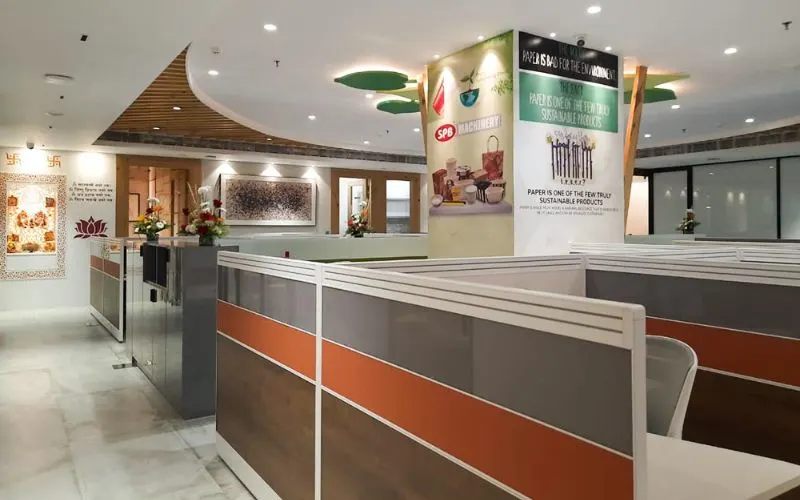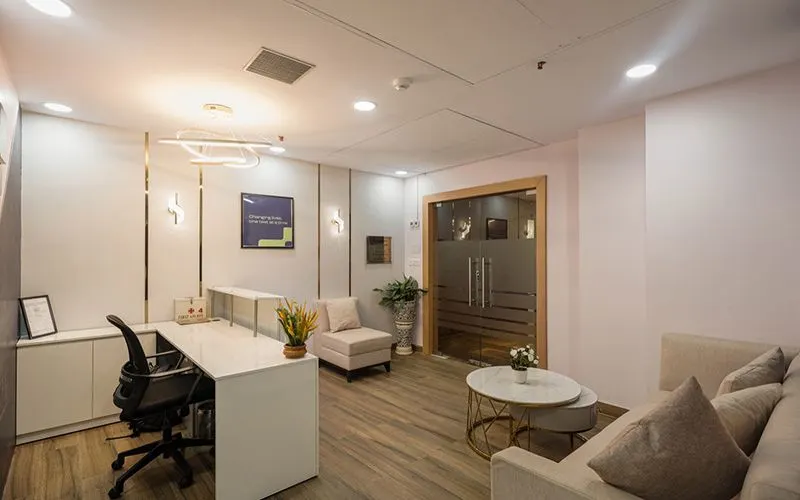- chitralekha@ceebeedesignstudio.com
- Home Owner Bangalore - +91 8697306015
- Home Owner Kolkata - +91 8697306015
- Other Enquiry - +91 91470 08329

By :
CeeBeeDesignStudio

May 19, 2025

We’ve all been there. You walk into a drab, cookie-cutter office, and you just feel the life drain out of you. Fluorescent lighting buzzing overhead, endless rows of identical desks… no wonder everyone’s glued to their screens, desperate for a coffee break. But here’s the good news – the era of those soul-sapping workspaces is on its way out. In its place? Flexible workspaces. And they’re changing the game in ways we never thought possible.
So, how exactly are these dynamic spaces shaking up the world of commercial interior design? Let’s unpack it together.
Picture this: an office that can morph from a bustling brainstorming zone to a quiet, focused haven in mere minutes. A space that’s as agile as the team working in it. Sounds a bit dreamy, doesn’t it? But for today’s commercial interior designer in Bangalore – and indeed, designers everywhere – this is the new reality.
Why the shift? Well, businesses have woken up to the fact that the one-size-fits-all approach just doesn’t cut it anymore. Different people need different spaces, depending on the task at hand – and flexible workspaces cater to exactly that.
Before we dive into the nitty-gritty of design, let’s ask the obvious: why are flexible workspaces so in demand? The answer’s simple – the way we work has changed.
The pandemic showed us that we don’t need to be chained to one spot all day. We’ve embraced hybrid work, hot-desking, and remote collaborations. And people have realised they crave environments that adapt as quickly as they do.
Plus, let’s face it: rigid office spaces are expensive to maintain and painfully slow to evolve. Flexible spaces, on the other hand, are built for the long haul. They’re not just smart—they’re sophisticated. Sleek layouts, upscale finishes, and a refined, luxurious vibe that reflects today’s professional standards. Need to switch up your layout for a new project? No sweat. Hosting a client meeting one day and a team huddle the next? Sorted.
Here’s the heart of it: flexible workspaces put people first. And that’s a bit of a revelation in the world of office design, isn’t it?
Set aside endless desks and sterile boardrooms. The best interior designer in Bangalore would tell you that contemporary workplace design is mostly about establishing a human environment. A place where one may encourage the natural rhythms of work: the high points of teamwork, the quiet times of concentration, the unplanned conversations that inspire ideas.
Actually, it is a significant change. From workplaces that demand individuals to adjust, we are going to offices that fit people.
So, what does a flexible workspace actually look like? Let’s break it down.
1. Modular Furniture
Gone are the days of clunky desks that can’t be moved. Modular furniture is the name of the game. Think lightweight tables that can be pushed together for group work or pulled apart for solo focus. Stackable chairs. Mobile whiteboards.
The beauty? Teams can rearrange their environment on the fly – no facilities manager required.
2. Moveable Partitions
Walls that aren’t walls. Sounds odd, but it’s genius. Moveable partitions allow spaces to be reconfigured in minutes. One minute, you’ve got an open space for a team meeting. Next, you’ve created smaller zones for one-on-one chats.
It’s not just about function – it’s about giving people the power to shape their own space.
3. Variety of Zones
Here’s the secret sauce: different spaces for different tasks. Flexible workspaces typically have:
By weaving these zones together, commercial architects and designers create offices that cater to every workstyle, not just one.
Okay, let’s talk about the elephant in the room – aesthetics. Because let’s be honest, no one wants to work in a space that looks like a forgotten warehouse.
Flexible workspaces might be all about functionality, but they’re also about feeling. Colour schemes that energise without overwhelming. Natural materials that bring in a sense of calm. Lighting that’s bright when you need it, soft when you don’t.
A great commercial interior designer in Bangalore will blend form and function seamlessly. Because an office that looks good and works well? That’s a recipe for happy teams and big ideas.
Now, you might be thinking: “Sounds great – but how does it all come together?”
That’s where the pros step in. Space planning and execution are the backbone of any good design. It’s not just about shoving in modular desks and hoping for the best. It’s about thinking deeply about how people use the space and designing accordingly.
For example, where do people naturally gather? Where do they prefer to work quietly? Where does natural light pour in? It’s the job of a corporate interior designer to read these clues and translate them into a space that’s as intuitive as it is beautiful.
It’s one thing to talk theory, but let’s get real. How does this all play out on the ground?
The Hot-Desk Hub
Hot-desking has emerged as one of the main changes in flexible offices. People choose where to work every day instead of setting up workstations. Although this seems disorganised, clever storage options and well-defined areas really inspire individuals to keep things fresh, meet new coworkers, and move around.
The Multipurpose Meeting Room
Old-school meeting rooms? Usually a waste of space. But in a flexible workspace, these rooms are designed to morph. Maybe it’s a formal meeting room in the morning, a creative brainstorming spot in the afternoon, and a yoga studio by evening.
It’s all about getting more out of every square foot – because let’s be honest, rent’s not getting any cheaper.
The Wellness Zone
Flexible workspaces aren’t just about work, either. They’re about wellbeing. Many modern offices now include dedicated wellness spaces – think quiet pods, nap zones, or even small meditation corners. Little touches that remind people they’re human, not machines.
The most unfortunate aspect is that flexible offices are a strong marketing statement rather than being a pragmatic trend. A customer feels right away what the firm stands for when they enter a flexible, vibrant environment.
Is this a place that values collaboration? Agility? A human touch? These are the signals that flexible spaces send – without a single logo in sight.
It’s something every commercial architect and designer is thinking about these days. Because, at the end of the day, an office is more than just desks and chairs. It’s the physical expression of a brand’s values.
Let us not pretend, of course, that everything is perfect. Establishing flexible offices has a unique set of problems.
1. Juggling Privacy and Openness
Among the toughest problems is this one. Juggling that open, cooperative atmosphere with the desire for solitude. Nobody likes to be obliged to answer delicate calls in a room full of colleagues under pressure.
Like phone booths or acoustically protected barriers, clever design may assist. To do it correctly, however, one must approach it deliberately.
2. Managing Change Fatigue
Yet another glitch? Change wearsiness. Not everyone enjoys change, let us be honest. Even if it will benefit us. If flexible design is thrown onto teams without justification, they may get overwhelmed.
The optimal line of action is Engage participants in the process. Let them help to define the gaps. After all, daily users of it are them.
What then should flexible offices look like? In the years ahead, will even more daring designs be seen?
Usually. We will utilise space differently as technology develops. Imagine sensors based on occupancy that change temperature and lighting. Alternatively artificial intelligence that guides teams towards the ideal location for their daily operations.
Fundamentally, however, the direction of commercial interior design will always return to individuals. Designing environments that complement our present working style as well as our future one.
Technology is one very essential component of the flexible workstation jigsaw. It's no secret that our daily digital choices are determining our location and method of working. From integrated project management systems to smart lighting systems, technology has evolved into the unseen backbone, allowing flexibility.
By means of booking systems for hot desks and meeting spaces, technology also provides flexibility. Real-time occupancy data allows staff members to schedule their daily activities around the areas most suited for their job free from conflict or lost time.
The ideal corporate interior designer will ultimately know how to subtly integrate technology into every nook and crevice of your business so that your workstation is as clever and dynamic as your staff.

To redefine your office environment with flexible, modern designs, trust a leading company like CeeBeeDesignStudio. Our luxury interior design solutions cater to clients and businesses of every size and industry. From boutique creative studios to expansive corporate offices, we’re experts in crafting functional and elegant workspaces. Here’s why you should partner with us for your office design needs:
One point of emphasis should be the fact that flexible offices are not a fad. They reflect a more widespread shift in our perspective on life and work.
People want surroundings as active as they are. Workplaces that change and adapt rather than restricting development. And it sums up the ideal brief for the best interior designer Bangalore has to have.
It is about realising the workplace is a live, breathing ecosystem changing with the people bringing it to life.
So, how’s your office shaping up? Could it do with a rethink? Maybe you’ve already embraced flexible design – or maybe you’re still stuck in the era of cubicles and water coolers.
Either way, it’s worth taking a walk around and asking: does this space work for us? Or is it time for a refresh?
If you’re feeling inspired – or just a bit overwhelmed – don’t stress. There are talented commercial interior designers in Bangalore (and beyond) ready to help. From the big picture of space planning to the tiniest detail of modern office decor, they’ve got your back.
After all, in the world of flexible workspaces, there’s no such thing as a one-size-fits-all solution. And that’s exactly what makes it so exciting.
Q1. How does a flexible workspace impact employee well-being?
Flexible offices inspire mobility and adaptation, which helps to lower stress and stop tiredness. These settings encourage mental health and innovation by letting staff members decide where and how they work.
Q2. Do flexible workspaces cost more than traditional layouts?
No! Although initial outlay for modular furniture and clever space design may seem more, flexible offices may save money over time by meeting changing demands without substantial upgrades.
Q3. How do you maintain flexibility in small office spaces?
Flexibility can come from small areas! Thoughtful zoning, adjustable separators, and folding furniture help to provide variety without feeling confined.
Q4. Can flexible workspaces work in traditional industries?
Yes. Flexible aspects even help more conventional industries such as law firms or banking. Any environment may benefit from quiet rooms for intense work, adaptable conference spaces, and cosy breakout areas.
Cee Bee Design Studio is a top-tier interior design consultancy, excelling in Interior Decoration and Turn Key Execution of Interior Works. With a strong presence in Kolkata and Bangalore, we have transformed over 1000+ residential projects and 300+ commercial spaces. Our team's commitment to excellence and innovation ensures a remarkable design experience for every client. Let's bring your dream space to life.
How To Incorporate Wash Basin Designs Into...
By: CeeBeeDesignStudio10 Home Library Designs To Revamp Your Reading...
By: CeeBeeDesignStudio7 Inspiring Bedroom Decor Ideas For The Season
By: CeeBeeDesignStudioHow To Decorate A Living Room On A Budget?
By: CeeBeeDesignStudio